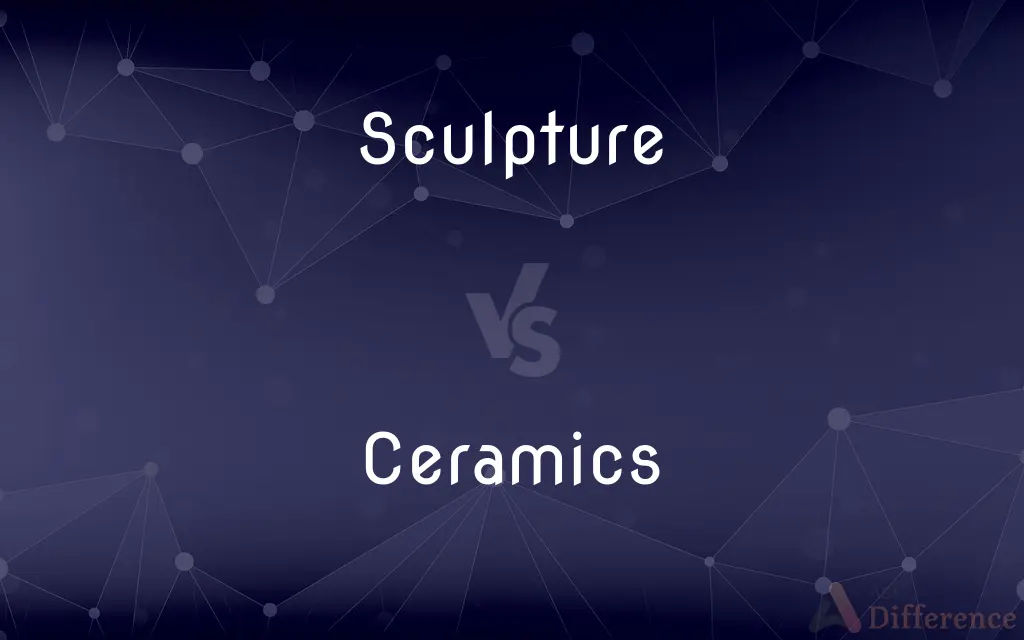Sculpture vs. Ceramics — What's the Difference?
By Maham Liaqat & Fiza Rafique — Updated on August 16, 2024
Sculpture is an art form creating three-dimensional works from various materials; ceramics focuses on objects made from clay and hardened by heat.

Difference Between Sculpture and Ceramics
Table of Contents
ADVERTISEMENT
Key Differences
Sculpture is a broad category of the visual arts that involves the creation of three-dimensional works, which can be either freestanding or in relief. Sculptors use a variety of materials, including metal, stone, wood, and plastic, employing techniques such as carving, modeling, and casting. Ceramics, on the other hand, specifically refers to the art of making objects (such as pots, dishes, and art pieces) out of clay and other ceramic materials, which are then subjected to high temperatures in a kiln to harden them.
All ceramics can be considered a form of sculpture when they are created with an aesthetic purpose in mind, but not all sculptures are ceramics. Ceramics is distinguished by its material (clay) and its process (firing), which are not limitations imposed on sculpture as a whole. Sculpture can range from monumental public artworks to small, intricate pieces, and it can be both functional and purely decorative. Ceramic art, while often functional, also includes pieces created solely for aesthetic appreciation, blurring the lines between utility and art.
The techniques and skills required for ceramics include wheel throwing, hand building, glazing, and firing, which are distinct from those used in other sculptural practices. Sculptors working with other materials may employ welding, chiseling, or assembling, depending on their medium. Despite these differences, both sculpture and ceramics share a fundamental focus on form, volume, and the spatial relationship of the artwork to its surroundings.
Historically, ceramics has been a part of human culture for thousands of years, serving both utilitarian and decorative purposes. Sculpture, similarly, has a long history in human civilization, with ancient cultures creating works that range from the purely representational to the highly abstract. Both forms of art have evolved over time, reflecting changes in cultural values, artistic trends, and technological advancements.
Comparison Chart
Definition
The art of creating three-dimensional works from various materials
The art of making objects from clay and other ceramic materials, hardened by heat
ADVERTISEMENT
Materials
Metal, stone, wood, plastic, etc.
Clay-based materials, including earthenware, stoneware, and porcelain
Techniques
Carving, casting, modeling, assembling
Wheel throwing, hand building, glazing, firing
Functions
Decorative, commemorative, functional (to a lesser extent)
Primarily functional (e.g., dishes, pots), but also decorative
Historical Use
Used for religious, commemorative, and decorative purposes across cultures
Used for domestic, ritualistic, and decorative purposes throughout history
Compare with Definitions
Sculpture
A three-dimensional artwork created by shaping or combining materials.
Michelangelo's David is a renowned marble sculpture.
Ceramics
Objects made from clay that are shaped and then hardened by heat.
Porcelain vases are highly valued ceramics.
Sculpture
Can be abstract or representational, focusing on form and space.
Henry Moore's sculptures explore organic forms and voids.
Ceramics
Historically important in many cultures.
Ancient Greek pottery is renowned for its aesthetic and historical significance.
Sculpture
Techniques vary widely based on the medium.
Bronze sculptures are often made using the lost-wax casting method.
Ceramics
Firing in a kiln is a crucial process.
Raku firing is a unique, low-temperature firing process creating distinctive effects.
Sculpture
Engages the viewer in a spatial dialogue.
Contemporary sculptures often invite viewers to interact with or move around the piece.
Ceramics
Includes both art objects and functional ware.
Ceramic bowls and plates are common in households.
Sculpture
Sculptures can be monumental or small-scale.
The Sphinx in Egypt is an example of monumental sculpture.
Ceramics
Techniques like glazing add color and finish.
Glazed ceramic tiles are used for both decoration and durability.
Sculpture
The art or practice of shaping figures or designs in the round or in relief, as by chiseling marble, modeling clay, or casting in metal.
Ceramics
Any of various hard, brittle, heat-resistant and corrosion-resistant materials made by shaping and then firing a nonmetallic mineral, such as clay, at a high temperature.
Sculpture
A work of art created by sculpture.
Ceramics
An object, such as earthenware, porcelain, or tile, made of ceramic.
Sculpture
(countable) A three dimensional work of art created by shaping malleable objects and letting them harden or by chipping away pieces from a rock (sculpting).
Ceramics
Ceramics (used with a sing. verb) The art or technique of making objects of ceramic, especially from fired clay.
Sculpture
To form with the chisel on, in, or from, wood, stone, or metal; to carve; to engrave.
Ceramics
The art or science of making ceramic objects.
Sculpture
A three-dimensional work of plastic art
Ceramics
The art of making things of baked clay; as pottery, tiles, etc.
Sculpture
Creating figures or designs in three dimensions
Ceramics
Work formed of clay in whole or in part, and baked; as, vases, urns, etc.
Sculpture
Create by shaping stone or wood or any other hard material;
Sculpt a swan out of a block of ice
Ceramics
The art of making and decorating pottery
Common Curiosities
Can ceramics be considered a type of sculpture?
Yes, ceramic works that are created with an aesthetic purpose can be considered a form of sculpture, particularly when they focus on form and artistic expression rather than utility.
What role has sculpture played in history?
Sculpture has been used for religious, commemorative, and decorative purposes, reflecting cultural values and artistic trends across civilizations.
What distinguishes sculpture from ceramics?
Sculpture encompasses a wide range of three-dimensional art made from various materials, while ceramics specifically refers to items made from clay and hardened by heat.
How do artists choose between sculpture and ceramics for their work?
Artists may choose based on the material's expressive potential, the desired outcome (functional vs. purely artistic), and their personal skills and preferences.
What are some common techniques used in ceramics?
Common techniques include wheel throwing, hand building, glazing, and firing in a kiln.
How do the functions of sculpture and ceramics differ?
Sculptures are primarily decorative or commemorative, whereas ceramics can be both functional (e.g., vessels, plates) and decorative.
How has the material choice for sculpture evolved over time?
Material choice in sculpture has evolved with technological advancements and changing artistic trends, expanding from traditional materials like stone and metal to include plastics and mixed media.
Are there any overlaps between sculpture and ceramics?
Yes, there are overlaps in form and aesthetic considerations, and ceramics can be presented as sculptural art when the focus is on artistic expression rather than functionality.
What impact does the firing process have on ceramic art?
Firing hardens the clay, making it durable and permanent, and it also affects the final appearance, especially in terms of glaze colors and textures.
How do contemporary artists blend sculpture and ceramics?
Contemporary artists may blend the two by creating sculptural works that utilize ceramic materials and techniques, challenging traditional boundaries between functional ceramics and sculptural art.
Share Your Discovery

Previous Comparison
Bandwidth vs. Data Rate
Next Comparison
Espresso vs. Cold BrewAuthor Spotlight
Written by
Maham LiaqatCo-written by
Fiza RafiqueFiza Rafique is a skilled content writer at AskDifference.com, where she meticulously refines and enhances written pieces. Drawing from her vast editorial expertise, Fiza ensures clarity, accuracy, and precision in every article. Passionate about language, she continually seeks to elevate the quality of content for readers worldwide.














































